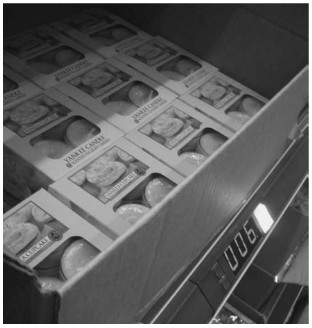Pick to light or pick by light uses light-indicator modules mounted to shelving, flow racks, pallet racks or other storage locations. To begin the process a barcode is scanned on a pick tote or shipping carton which denotes the next order number to be picked. This communicates to the system that the operator is ready to pick. The system then sends a message to the zone in which the operator is stationed and all the pick locations for that particular order light up at once. A digital display tells the operator the quantity to pick; once this has been picked the operator turns the light off to confirm the pick. The operator can then move on to the next location indicated. The pickers continue until the pick in their area is completed. The tote is then passed to the next zone for the rest of the order to be picked. This is a typical pick-and-pass method of picking. All information is exchanged in real time with the enterprise resource planning (ERP) or WMS system. Unlike scanning and voice picking, which are sequential in nature, all locations are indicated to the operator at the same time. This means that the operator can choose the best pick path. Pick by light necessitates operators being stationed in zones looking after a certain quantity of SKUs. The order tote moves between zones on a conveyor, cart or other transportation method. As operators are based in a specific area, this reduces the amount of walking required within the warehouse. At the end of the pick an operator will check the order number, check the weight of the consignment, attach an address label, add the delivery documentation and signify the carrier if multiple carriers are used. By getting the operator to the right location each time, the picking process is greatly improved and productivity increased. Training is relatively simple and is conducive to the use of temporary labor and seasonal employees. Some companies have introduced portable pick-by-light systems that can be moved around the warehouse as required or to a temporary warehouse to cover peaks in business. As with voice, there is very little upheaval when implementing the system. The lights can be retro fitted onto shelving and racking. The system can also be used in conjunction with carousels.
In terms of systems integration, pick to light is relatively simple. It requires the downloading of a file with the order number, product codes, locations and quantities. It can easily deal with part cases and individual items.

Figure 6.2: Pick to light

